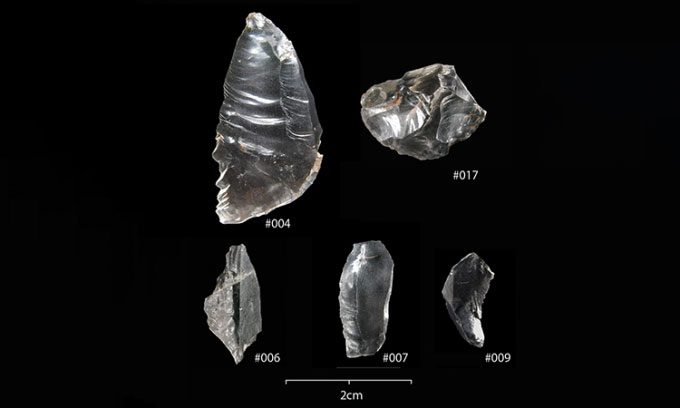Scientists Discover a Large Concentration of Quartz Crystals at Burial Mounds in Dorstone, with the Largest Measuring 34mm.
Nick Overton, an archaeologist at the University of Manchester, along with colleagues, discovered 337 transparent quartz fragments known as “rock crystals” at a 6,000-year-old ceremonial site on Dorstone Hill in western England, Live Science reported on August 18. The research was recently published in the Cambridge Archaeological Journal.

Some large quartz crystal fragments at the Dorstone archaeological site. (Photo: Nick Overton).
In addition to their water-like transparency, some of the crystal fragments are prismatic, splitting white light into a visible rainbow spectrum. The quartz crystals also exhibit triboluminescence, a property that may have encouraged the fracturing of the crystals into smaller pieces, Overton noted.
“If you strike two crystals together, they emit faint blue sparks, which is quite impressive. This would have been an exciting experience since quartz was relatively rare and special during this period, when there was no glass or other transparent solid materials,” he explained.
Overton stated that the crystal fragments are scattered around the Dorstone site, with a concentration at the burial mounds. Some of the largest fragments appear to be grave goods placed in cremation burial pits.
There are no local sources of quartz crystals. Therefore, it is likely that these crystals originated from a cave in the Snowdonia region of North Wales, about 130 kilometers away, or from a site at St David’s Head, approximately 160 kilometers distant. It seems that the quartz was transported to Dorstone Hill as large crystals up to 10cm long through a trade network.
Analysis indicates that these large crystals were skillfully chipped into smaller pieces using techniques typically employed for flint, but these crystal fragments were not used to create tools. Instead, many pieces were collected and placed at Dorstone Hill, particularly on the burial mounds. The largest fragment found by the research team measures 34mm.
The 337 quartz fragments at Dorstone represent the largest collection of processed rock crystals ever found in England and Ireland. While quartz crystal fragments have previously been discovered at other Neolithic burial sites in England and Ireland, they were often overlooked.
“I think it is essential to highlight how remarkable and interesting this material is. It can help us understand other aspects of the Neolithic, such as trade connections or exchanges, as well as how ancient people thought and used materials,” Overton said.


















































